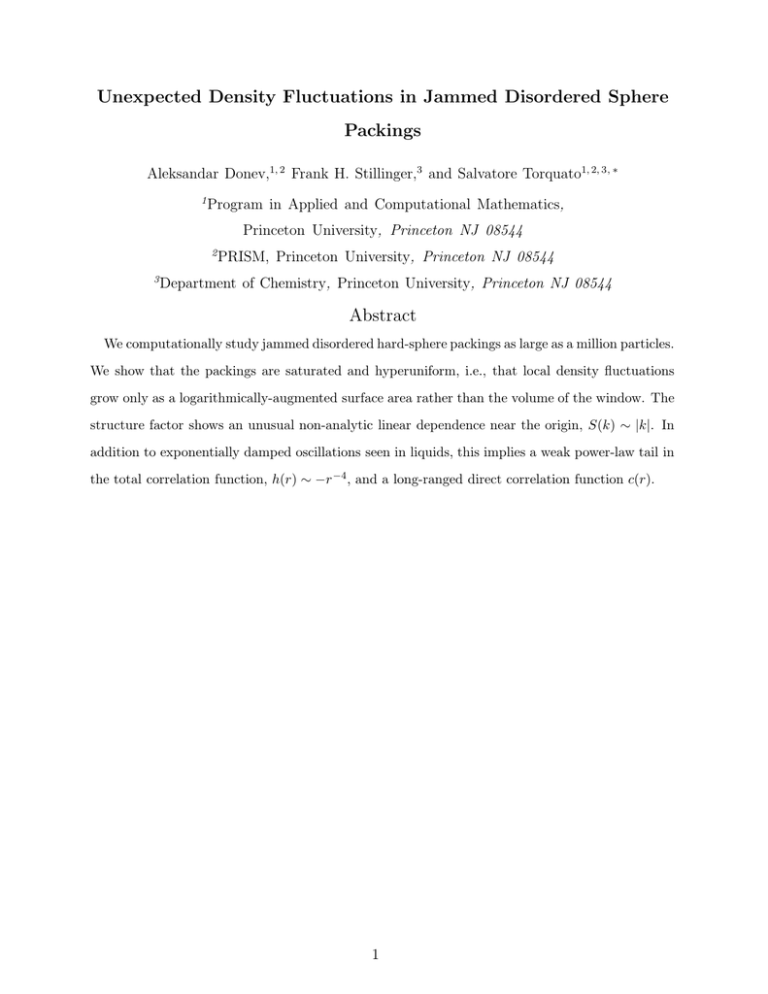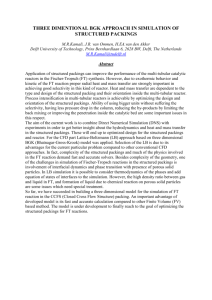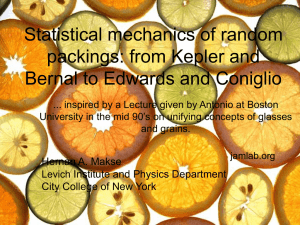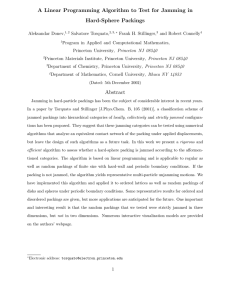Unexpected Density Fluctuations in Jammed Disordered Sphere Packings
advertisement

Unexpected Density Fluctuations in Jammed Disordered Sphere Packings Aleksandar Donev,1, 2 Frank H. Stillinger,3 and Salvatore Torquato1, 2, 3, ∗ 1 Program in Applied and Computational Mathematics, Princeton University, Princeton NJ 08544 2 3 PRISM, Princeton University, Princeton NJ 08544 Department of Chemistry, Princeton University, Princeton NJ 08544 Abstract We computationally study jammed disordered hard-sphere packings as large as a million particles. We show that the packings are saturated and hyperuniform, i.e., that local density fluctuations grow only as a logarithmically-augmented surface area rather than the volume of the window. The structure factor shows an unusual non-analytic linear dependence near the origin, S(k) ∼ |k|. In addition to exponentially damped oscillations seen in liquids, this implies a weak power-law tail in the total correlation function, h(r) ∼ −r −4 , and a long-ranged direct correlation function c(r). 1 The characterization of local density fluctuations in many-particle systems is a problem of great fundamental interest in the study of condensed matter, including atomic, molecular and granular materials. In particular, long-wavelength density fluctuations are important to such diverse fields as statistical mechanics, granular flow, and even cosmology (see Ref. [1] and references therein). Previous work by some of us [1] considered the quantitative characterization of density fluctuations in point patterns, and in particular, those in which infinite-wavelength fluctuations are completely suppressed, i.e., the structure factor S(k) vanishes at the origin. In these so-called hyperuniform (or superhomogeneous [2]) systems, the variance in the number of points inside a large window grows slower than the volume of the window, typically like the window surface area. Known examples include ordered lattices and quasi-crystals [1, 2], but it is important to identify statistically homogeneous and isotropic systems (e.g., glasses) that are hyperuniform. For equilibrium liquids and crystals, S(k = 0) is proportional to the isothermal compressibility and is thus positive. Strictly jammed sphere packings [3] are rigorously incompressible (and non-shearable), but they are also nonequilibrium systems. In Ref. [1], it was conjectured that all saturated [4] strictly jammed packings are hyperuniform. Of particular importance are disordered jammed packings, especially the maximally random jammed (MRJ) state [5]. The MRJ state is the most disordered among all strictly jammed packings and is related to the view of jamming as a rigidity transition and/or dynamic arrest in both granular [6] and glassy materials [7]. Hyperuniformity involves an “inverted critical phenomenon” in which the range of the direct correlation function c(r) diverges [1]. It is hence of great interest to test whether disordered jammed sphere packings are hyperuniform. In this Letter, we demonstrate that MRJ packings are indeed hyperuniform and saturated. Moreover, we observe an unusual non-analytic structure factor S(k) ∼ |k| for k → 0, or equivalently, a quasi-long ranged negative tail of the total pair correlation function h(r) ∼ −r −4 , just as found in diverse systems such as the early Universe [2] and in liquid helium [8]. We prepare jammed packings of hard spheres under periodic boundary conditions using a modified Lubachevsky-Stillinger (LS) packing algorithm (see Ref. [9]). The generated disordered sphere packings typically have volume fractions in the range φ = 0.64 − 0.65, and to a good approximation the packings should be representative of the MRJ state. For this study, we have generated a dozen packings of N = 105 and N = 106 particles jammed up to a reduced pressure of 1012 using an expansion rate of 10−3 [9] with φ ≈ 0.644. Generating 2 such unprecedented one-million-particle packings was neccesary in order to study large-scale density fluctuations without relying on dubious extrapolations. The packings generated by the LS and other algorithms have a significant fraction (∼ 2.5%) of rattling particles that are not truly jammed but can rattle inside a small cage formed by their jammed neighbors [9]. Assuming that the rattlers are more or less randomly distributed among all particles, a hyperuniform packing from which the rattlers are then removed would have S(0) ≈ 0.025 > 0. Similarly, the hyperuniformity could be destroyed by randomly filling large-enough voids with additional rattlers. It is therefore important to verify that the jammed packings are saturated, i.e., that there are no voids large enough to insert additional rattlers. Figure 1 shows the complementary cumulative pore-size distribution [10] F (δ), which gives the probability that a sphere of diameter δ could be inserted into the void space, with and without the rattlers. Clearly there is no room to insert any additional rattlers; the largest observed voids are around δmax ≈ 0.8D. The algorithm used to produce the packings appears to fill all void cages with particles. When periodic boundary conditions apply with a periodic box of length L, particle correlations can only be studied up to a distance L/2, and there are large finite-size corrections for distances comparable to L. Additionally, as we show later, strong statistical fluctuations appear due to finite system size, making it necessary to use even larger systems to measure pair correlations at large distances. In reciprocal space, S(k) can only be measured for k ≥ 2π/L, with large discretization errors for the smallest wavevectors. To overcome these finite-size effects, it was necessary to generate packings of one million particles. Consider a large isotropic three-dimensional packing of N hard spheres of diameter D, with average number density ρ = N/V and average volume fraction φ = πρD 3 /6. We employ the usual pair correlation function g2 (x = r/D) or the total correlation function h(x) = g2 (x)−1 in real space, or the equivalent Fourier representation given by the structure factor sin (Kx) 2 x h(x)dx. Kx 0 R∞ Of particular interest are the moments of h(x), hxn i = 0 xn h(x)dx. Computer-generated S(K = kD) = 1 + 24φ Z ∞ packings are always finite, and thus binning techniques must be used to obtain probability densities like h. Accordingly, we prefer to use the more readily measurable excess coordina- 3 0 1×10 With rattlers Without FCC -3 F(δ) 1×10 -6 1×10 -9 1×10 0 0.25 0.5 1 0.75 δ/D 1.25 1.5 Figure 1: (Color online) The cumulative pore-size distribution F (δ) for a (single) packing with N = 105 particles, with and without the rattlers. The method of trial spheres with 2 · 10 9 trials was used [10]. A very similar F (δ) with cutoff around δ max ≈ 0.8D is observed when N = 106 , when rattlers are present. The cutoff is however not as sharply defined as it is for the FCC crystal, shown for comparison. tion ∆Z (x) = 1 + 24φ Z x w 2 h(w)dw. 0 This is the average excess number of points inside a spherical window of radius xD centered at a particle, compared to the ideal-gas expectation 8φx3 . Any integral containing h(x) can easily be represented in terms of ∆Z (x) using integration by parts. For the structure factor we get S (K) = limR→∞ S(K, R), where sin (KR) S(K, R) = ∆Z (R) − KR Z R ∆Z (x) 0 d sin (Kx) dx. dx Kx This has quadratic behavior near k = 0 when expanded in a Taylor series, Z K2 ∞ S (K) ≈ S(0) + x [∆Z(x) − S(0)] dx, 3 0 (1) (2) where S(0) = ∆Z (x → ∞) vanishes for a hyperuniform system. For large x, an explicit finite-size correction of order 1/N needs to be applied to the infinite-system excess coor4 dination, ∆Z(x) ≈ S(0) [1 − 8φx3 /N ] [11], as it is clear that the excess coordination must vanish for windows as large as the whole system. Figure 2 shows S(k) for the simulated packings as obtained via a direct Fourier transform P 2 N −1 (DFT) of the particle positions, S(k) = N i=1 exp (ik · ri ) , where k is a reciprocal lattice vector for the periodic unit cell [12]. To obtain an approximation to the radially sym- metric infinite-system S(k), we average over the reciprocal lattice vectors inside a spherical shell of thickness 2π/L. Using Eq. (1) together with a numerical (truncated) ∆Z(x) quickly gives S(k) over a wide range of wavelengths. However, the behavior near the origin is not reliable since it depends on the analytic extension for the tail of ∆Z(x). The results of the DFT calculations are shown in Fig. 2, and they closely match the one obtained from ∆Z(x) for wavelengths smaller than about 20 diameters. Figure 2 reveals that the saturated packing is indeed hyperuniform (as conjectured in Ref. [1]) to within S(0) < 10−3 . The behavior of S(k) near the origin is very surprising. The observed S(k) follows closely a non-analytic linear relationship [13] well-fitted by S(K) ≈ 6.1 · 10−4 + 3.4 · 10−3 K over the whole range K/2π < 0.4. By contrast, analytic quadratic behavior is observed for a liquid sample at φ = 0.49, as shown in the figure. Theoretical finite-size corrections to the small-k behavior of S(k) have only been considered for relatively low-density liquid systems with relatively small N [11], and are not useful for our purposes. Although estimating the corrections to the DFT data analytically is certainly desirable, such corrections appear to be rather small at least for the well-understood liquid at φ = 0.49. Comparison among the different N = 106 samples shows that statistical fluctuations in S(k) near the origin are very small. Equation (2) shows that if h is truly short-ranged, the structure factor must be analytic (i.e., an even power of k, usually quadratic), near the origin. Our numerical observations point strongly to a linear S(K) for small K. This observation S(K) ∼ |K| implies a negative algebraic power-law tail h(x) ∼ −x−4 uncharacteristic of liquid states and typically only seen in systems with long-range interactions. Such non-analytic behavior is assumed in the so-called Harrison-Zeldovich power spectrum of the density fluctuations in the early Universe [2] and is also seen in the ground state of liquid helium [8]. A long-ranged tail must appear in the direct correlation function c(r) for a strictly hyperuniform system due to the divergence of c̃(0), in a kind of “inverted critical phenomenon” [1]. Such a tail is uncharacteristic of liquids where the range of c(r) is substantially limited to the range of the 5 5 0.04 Linear fit Quadratic predictions c(r) 6 DFT (N=10 ) 6 DFT at φ=0.49 (N=10 ) 4 5 0 -5 0.02 S(k) 3 PY at φ=0.49 6 OZ (N=10 ) -10 -15 0 1 2 0 0.25 2 r/D 3 4 0 0.5 5 DFT (N=10 ) PY at φ=0.49 1 6 From ∆Z(x) (N=10 ) 0 0 0.5 1 kD/2π 1.5 2 Figure 2: (Color online) Structure factor for a jammed 10 6 -particle packing (φ = 0.642) and for a hard-sphere liquid near the freezing point (φ = 0.49), as obtained via two alternative numerical methods and also from the Percus-Yevick (PY) theory [14]. DFT results are also shown over a larger range of K for a jammed 105 -particle packing (φ = 0.643). The left inset shows the range near the origin, revealing that while a parabola matches the liquid data reasonably well [ S(K) ≈ 0.02 + 4 · 10−3 K 2 according to PY theory, which is known to underestimate S(0) ], it does not appear appropriate for the jammed packing for large-to-intermediate wavelengths [as obtained from Eq. (2)]. The right inset shows c(r) convolved with a narrow Gaussian [due to numerical truncation of S(k)]. The peak at r = D is essentially a δ-function. interaction potential. The direct correlation function can numerically be obtained from its Fourier transform via the Ornstein-Zernike (OZ) equation, c̃(k) = (π/6φ) [S(k) − 1] /S(k), and we have shown it in the inset in Fig. 2, along with the corresponding Percus-Yevick (PY) anzatz [14] for c(r) at φ = 0.49 which makes the approximation that c(r) vanishes outside the core. Two unusual features relative to the liquid are observed for our jammed 6 packing. First, there is a positive δ-function at contact corresponding to the Z̄ = 6 average touching neighbours around each jammed particle [9]. Second, there is a relatively long tail outside the core, the exact form of which depends on the behavior of S(k) around the origin [15]. The numerical coefficient in the power-law tail in h(x) is very small, ∆Z(x) ≈ 4.4·10−3 x−1 , and cannot be directly observed, as we will show shortly. It is however possible to observe its effect on large-scale density fluctuations. For monodisperse hard sphere systems it suffices to focus only on the positions of the sphere centers and consider density fluctuations in point patterns. Following Ref. [1], consider moving a spherical window of radius R = XD through a point pattern and recording the number of points inside the window N (X). The number variance is exactly [1], σ 2 (X) = N 2 (X) − hN (X)i2 3φ (2X)2 ∆Z0 (2X) − ∆Z2 (2X) = 2 where ∆Zn (x) = Rx 0 w n ∆Z(w)dw denotes a running moment of ∆Z. Asymptotically, for large windows, in an infinite system with analytic S(k), σ 2 (X) ≈ AX 3 + BX 2 , where A = 8φ (1 + 24φ hx2 i) = 8φS(0) is the volume fluctuation coefficient, and B = −144φ2 hx3 i = 6φ∆Z0 (x → ∞) is the surface fluctuation coefficient. When a non-integrable power-law tail exists in ∆Z(x), asymptotically the “surface” fluctuation coefficient contains an additional logarithmic term, B(X) = B0 + C ln X. Such a logarithmic correction does not appear for any of the examples studied in Ref. [1]. Explicit finite-size effects for non-hyperuniform systems yield a correction A(X) = 8φS(0) [1 − 8φX 3 /N ] [16]. Figure 3 shows numerical results for the number variance as a function of window size, along with the predicted asymptotic dependence, including both the logarithmic and N −1 corrections [17]. Both corrections need to be included in order to observe this close a match between the data and theory. The constants S(0) and C were obtained from the linear fit to S(k), while B0 ≈ 1.02 was obtained by numerically integrating ∆Z(x), as explained shortly [18]. We now turn our attention to real space to observe directly the large-distance behavior of h or equivalently ∆Z. For equilibrium liquids with short-ranged potentials, it is expected that the asymptotic behavior of h(x) is exponentially damped oscillatory [19, 20], of the form h(x) ∼ C exp (−x/ξ) cos [K0 (x − x0 )] . x 7 (3) 2500 All terms Surface term Data 2000 2 σ (R) 1500 1000 500 0 0 10 20 R/D 30 40 50 Figure 3: (Color online) The variance σ 2 versus window radius for a jammed 10 6 -particle packing. √ The uncertainty in the variance (shown with error bars) is estimated to be σ 2 / M , where M = 104 is the number of windows used for a given window. Also shown is the theoretically predicted dependence of the form AX 3 + CX 2 ln X + B0 X 2 , along with just the surface term B0 X 2 , which dominates the density fluctuations. However, it is not clear whether the decay is still exponential for glass-like nonequilibrum jammed systems. Previous studies have looked at much smaller systems, where explicit finite-size effects dominate, and also focused on the liquid phase [11]. Figure 4 shows the numerical ∆Z(x) along with a relatively good exponentially damped oscillatory fit [21] ∆Z(x) ≈ 5.47x exp(−x/1.83) cos(7.56x − 2.86) over the range 5 < x < 15. It would be desirable to look at larger x and, in particular, directly observe the long-range inverse power tail predicted from the linear behavior of S(k). The use of cubic periodic boundary conditions p implies that pair distances up to xmax = 3 πN/24φ ≈ 50 can be studied. However, it is not possible to measure the pair correlations for x > 15 due to statistical variations √ among finite systems, estimated to lead to an uncertainty of the order δZ(x) ≈ σ(x)/ N . In fact, within the range of validity of the observed ∆Z(x) the damped oscillatory fit is 8 3 10 1 2 Excess coordination ∆Z(x) δZ(x) Asympt. fit 0.1 1 0.01 0 10 5 20 15 0 ∆Z0(x) 0.4 -1 ∆Z1(x) 0.3 0.2 -2 0.1 0 -3 0 2.5 5 7.5 0 5 10 x=r/D 10 12.5 15 15 17.5 20 20 Figure 4: (Color online) Excess coordination for a jammed 10 6 -particle packing, along with the best fit of the form (3) for the tail, and the estimated uncertainty. Statistical fluctuations overcome the actual correlations after x ≈ 15. Averaging over 9 samples only reduces the fluctuations by a factor of 3, without revealing additional information. The top inset uses a logarithmic scale, and the bottom inset shows the zeroth and first running moments along with their asymptotic values as estimated from the tail fit. For the range of x shown, explicit finite-size corrections are small (less than 5%). perfectly appropriate. We smoothly combined the actual numerical data for x < 10 with the fitted decaying tail for x > 10, and numerical integration of this smoothed ∆Z(x) gives B0 ≈ 1.02 ± 0.02, as used in producing Fig. 3. This smoothed ∆Z(x) was used to obtain S(k) via Eq. (1) when producing Fig. 2. We have given computational results for million-particle jammed disordered hard sphere packings demonstrating that they are staurated and hyperuniform. We found that S(k) is nonanalytic at the origin in striking contrast to liquid behavior. There are many open fasci9 nating questions. Can a geometrical significance be attached to the period of oscillations K 0 in the jamming limit, or to the cutoff of F (δ)? We believe that the strict jamming and saturation conditions demand hyperuniformity of our packings. We conjecture that the observed nonanalytic behavior of S(k) ∼ k is a direct consequence of the condition of maximal disorder on the jammed packing. The exponent p appears to increase with increasing order: It approaches infinity for ordered lattices, is two for perturbed lattices, and is one for MRJ. In this sense, the MRJ packings are markedly more disordered: they have macroscopic density fluctuations which are much larger than crystalline packings. Quantitative understanding of this aspect of disorder and its relation to density fluctuations remains a fascinating open problem. This work was supported in part by the National Science Foundation under Grant No. DMS-0312067. ∗ Electronic address: torquato@electron.princeton.edu [1] S. Torquato and F. H. Stillinger, Phys. Rev. E 68, 041113 (2003), ibid. 069901. [2] A. Gabrielli, M. Joyce, and F. S. Labini, Phys. Rev. D 65, 083523 (2002). [3] S. Torquato and F. H. Stillinger, J. Phys. Chem. B 105, 11849 (2001). [4] A saturated packing is one in which no additional particles can be added. [5] S. Torquato, T. M. Truskett, and P. G. Debenedetti, Phys. Rev. Lett. 84, 2064 (2000). [6] H. A. Makse, J. Brujic, and S. F. Edwards, The Physics of Granular Media (John Wiley & Sons, 2004), chap. Statistical Mechanics of Jammed Matter, pp. 45–86. [7] C. S. O’Hern, S. A. Langer, A. J. Liu, and S. R. Nagel, Phys. Rev. Lett. 86, 111 (2001). [8] L. Reatto and G. V. Chester, Phys. Rev. 155, 88 (1967). [9] A. Donev, S. Torquato, and F. H. Stillinger, Phys. Rev. E 71, 011105 (2005). [10] S. Torquato, Random Heterogeneous Materials (Springer-Verlag, New York, 2002). [11] J. J. Salacuse, A. R. Denton, and P. A. Egelstaff, Phys. Rev. E 53, 2382 (1996); A. Baumketner and Y. Hiwatari, Phys. Rev. E 63, 061201 (2001); M. Dijkstra and R. Evans, J. Chem. Phys. 112, 1449 (2000). [12] This calculation potentially involves many reciprocal lattice points and cannot easily and accurately be made faster using Fast Fourier Transforms (FFT). 10 [13] Since S(k) is an even function, its derivative must vanish at the origin for it to be analytic. [14] J. K. Percus and G. J. Yevick, Phys. Rev. 110, 1 (1958). [15] We used the linear fit to S(k) when producing the figure, implying c(r) ∼ r −2 . [16] F. L. Roman, J. A. White, and S. Velasco, J. Chem. Phys. 107, 4635 (1997); F. L. Roman, J. A. White, A. Gonzalez, and S. Velasco, J. Chem. Phys. 110, 9821 (1999). [17] Additional implicit finite size effects due to the periodicity of the system have been found to be significantly smaller in Ref. [16]. [18] The surface coefficient B0 cannot be determined from just the linear part of S(k) near the origin. [19] P. Perry and G. J. Throop, J. Chem. Phys. 57, 1827 (1972). [20] S. Torquato and F. H. Stillinger, J. Phys. Chem. B 106, 8354, ibid. 11406-11406 (2002). [21] Compare this fit to ξ ≈ 1.4 and K0 ≈ 7.9 as measured in R. Jullien, P. Jund, D. Caprion,and D. Quitmann, Phys. Rev. E 54, 6035 (1996). 11




